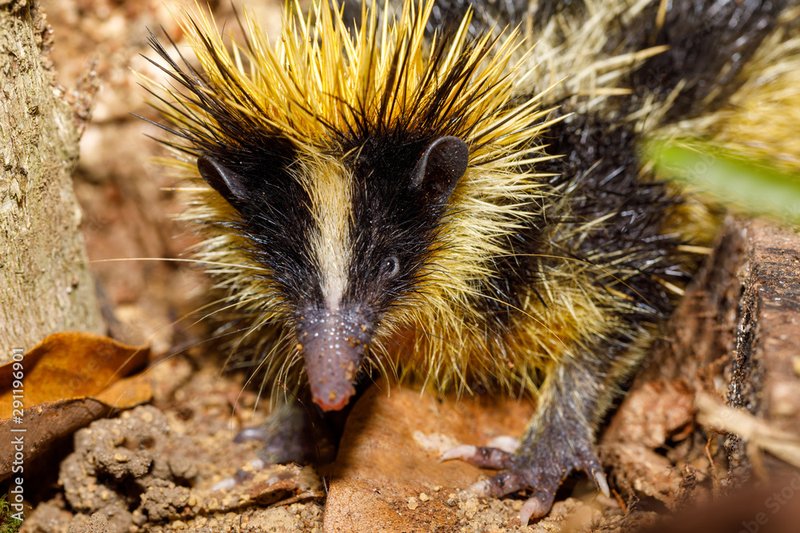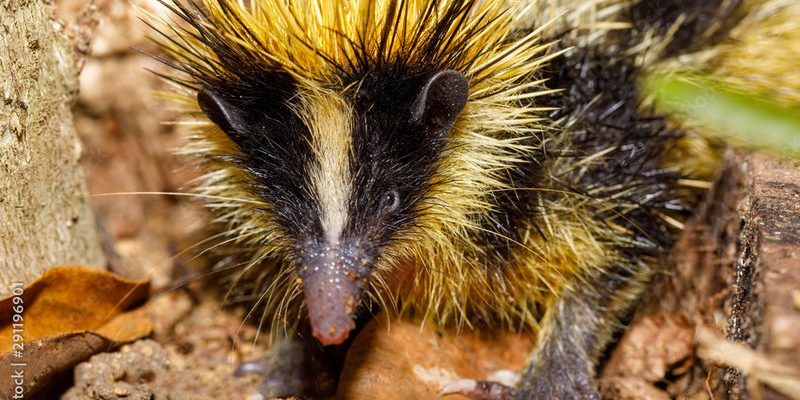
Imagine a small creature that’s a mix between a hedgehog and an otter, but instead of being found in chilly forests or by the water, this one calls the lush, tropical forests of Madagascar home. Meet the tenrec! This unique mammal is unlike any other. With its spiky fur, varied diet, and intriguing behavior, the tenrec is a hidden gem in the world of wildlife. But what exactly makes them so special?
Tenrecs belong to the family Tenrecidae and are fascinating creatures that adapt remarkably to their environment. They come in various shapes and sizes, showcasing features that might surprise you. If you were to picture them in your mind, think of a compact body covered in spines, but they also can be quite adorable with their fuzzy faces and curious nature. You might be wondering how these little critters fit into their ecosystem and what makes each of their species unique.
In this article, we’ll journey through the world of tenrecs, exploring their habitats, behaviors, diets, and much more. Trust me; you’ll want to stick around! From the way they communicate to their fascinating reproductive habits, the tenrec offers so much to discover.
Physical Characteristics of Tenrecs
Tenrecs are not just cute; they come with a variety of physical traits that help them thrive in their natural habitats. The most notable feature is, of course, their spiky fur, which serves as a defensive mechanism against predators. Unlike porcupines, though, tenrecs don’t have sharp quills. Instead, their spines are soft and can flatten when threatened—almost like a tiny, defensive pillow!
These mammals vary significantly in size and shape. Some species, like the common tenrec, can grow to about 12 inches long, while others, like the smaller streaked tenrec, may only be 4 inches long! Their coats range from black to brown, often with stripes or spots, providing them with camouflage in the dense vegetation of their surroundings. This adaptation is clever; it helps them avoid predators and catch unsuspecting prey.
Another fascinating aspect is their unique ability to curl up into a ball when frightened. They can use their spines as protection, much like a hedgehog. This defensive behavior not only provides safety but also showcases their remarkable adaptability to challenges they face in the wild.
Habitat and Distribution
Tenrecs are primarily found in Madagascar, a place so strikingly beautiful and biologically diverse. But the island isn’t their only home. Some species can also be found on the nearby African mainland, particularly in places like Tanzania and parts of the Democratic Republic of the Congo. The habitats range from dense rainforests to grasslands and even dry forests. Isn’t it amazing how they’ve adapted to thrive in such different environments?
These little creatures are superb burrowers and spend a lot of time underground, making their homes in the soil or under rocks. This behavior not only provides shelter but also helps them avoid extreme weather conditions. They’re quite the engineers when you think about it! Creating a cozy home underground keeps them safe from predators and offers a stable temperature.
You might also be interested to learn that tenrecs are nocturnal. They come to life when the sun sets, making their rounds in search of food and exploring their territory. Nighttime is their time, and it’s when their keen senses are fully alert, allowing them to find food and avoid danger.
Diet and Feeding Habits
When it comes to food, tenrecs have a diverse menu. They’re mostly insectivores, which means they love munching on insects such as crickets and beetles. However, they don’t stop there! Depending on the species and availability, tenrecs will also eat worms, fruit, and small vertebrates, showcasing their opportunistic feeding habits. They often forage through leaf litter and dig in the soil, using their sensitive snouts to sniff out tasty morsels.
Their eating habits can be fascinating to observe. Some tenrecs will hunt alone, while others may work in small groups. This social aspect of their behavior is intriguing, as it offers opportunities for communication and cooperation among them, especially when searching for food. It’s like having a little dinner party in the wild!
Tenrecs have also developed clever ways to store food. Some species will hide their food to save for later, showcasing their smart survival skills. This behavior shows their understanding of food scarcity and helps them prepare for leaner times, making them not only resourceful but also quite wise.
Reproduction and Lifespan
When it comes to reproduction, tenrecs have some interesting traits. Most species have a specific breeding season, typically aligned with the warm, rainy months in Madagascar. After a gestation period of about two to three months, a female tenrec can give birth to a surprising number of young—anywhere from two to a hefty fourteen! Just imagine the chaos of a tiny tenrec family running around!
Once born, these little ones are born blind and helpless, relying on their mother for warmth and nourishment. As they grow, they start developing their spines, which helps protect them from potential threats. This nurturing phase is crucial, and tenrec mothers are very attentive, ensuring their young stay safe until they’re ready to face the world on their own.
As for their lifespan, tenrecs can live up to five years in the wild, and sometimes longer in captivity. While this might seem short compared to other mammals, their lives are filled with action, exploration, and quirky behavior, making every day an adventure. You could say tenrecs are the embodiment of living life to the fullest, regardless of how long they have!
Conservation Status
Despite their fascinating traits, some species of tenrec face threats in their natural habitat. Habitat destruction is a primary concern, as deforestation and agriculture reduce the areas where they can thrive. Additionally, climate change poses significant risks, affecting food availability and altering their habitats. It’s alarming to think about how quickly their world is changing!
Conservation efforts are underway in Madagascar and surrounding areas to protect these unique creatures. Organizations are working to preserve their habitats and educate the public about their ecological importance. As wildlife enthusiasts, we can help spread awareness of tenrec conservation. Every little bit helps!
When it comes to protecting the tenrec, every action counts. Supporting sustainable practices and choosing to learn about these creatures can contribute to their continued survival. After all, we wouldn’t want to lose such a remarkable animal from our planet!
Interesting Facts About Tenrecs
| Size: | 4 to 12 inches long, depending on species |
| Weight: | From about 1 to 3 pounds |
| Habitat: | Madagascar and parts of Africa, including rainforests and grasslands |
| Diet: | Insects, worms, fruits, and small vertebrates |
| Lifespan: | Up to 5 years in the wild; longer in captivity |
FAQ
Are tenrecs related to hedgehogs?
While tenrecs and hedgehogs share a few physical similarities—like their spiny coats—they are not closely related. They belong to different families and have evolved separately. Tenrecs are unique to Madagascar, while hedgehogs can be found in various parts of the world, including Europe, Asia, and Africa. It’s a classic case of convergent evolution, where different species develop similar traits in response to similar environmental challenges.
What are the different types of tenrec species?
There are about 30 species of tenrec, each with its own unique characteristics. Some of the more well-known include the common tenrec, the streaked tenrec, and the lesser hedgehog tenrec. Each species has adapted to different niches within their habitat, showcasing the incredible diversity among these small mammals. For instance, the streaked tenrec is known for its vibrant stripes, while the lesser hedgehog tenrec resembles a mini hedgehog in appearance!
How do tenrecs communicate?
Tenrecs communicate through a combination of vocalizations and scents. They use a variety of sounds, from soft chirps to louder calls, helping them signal to each other, especially during mating season or when defending their territory. Additionally, they have scent glands that play a role in marking their territory and communicating with other tenrecs, which is critical in maintaining social structure and ensuring survival in the wild.
Can tenrecs be kept as pets?
While it may be tempting to keep a tenrec as a pet due to their cute appearance, it’s essential to remember they have specific care requirements. Tenrecs are nocturnal and need a specialized diet and environment to thrive. Additionally, their wild instincts make them challenging to handle. If you’re considering a pet, it’s often better to look into more domesticated species that can offer companionship without complex needs.
Do tenrecs hibernate?
Tenrecs do not hibernate in the traditional sense, but some species enter a state of torpor during colder months or dry seasons. This is a way to conserve energy when food is scarce. During this time, their metabolic rate decreases significantly, allowing them to survive on stored body fat until conditions improve. This adaptability is another testament to how resourceful tenrecs are in the wild!
What role do tenrecs play in their ecosystem?
Tenrecs serve an essential role in their ecosystem by helping control insect populations. By feeding on various insects and small invertebrates, they help maintain the balance of nature, preventing overpopulation of these pests. Additionally, their burrowing activities aerate the soil, which benefits plant growth. In this way, tenrecs contribute to the health of their environment!
Are tenrecs threatened by extinction?
Some species of tenrec are indeed at risk of extinction due to habitat loss, hunting, and climate change. Conservation efforts are crucial in helping to protect their habitats and raise awareness concerning their survival. As more people learn about the tenrec, the more support there is for initiatives aimed at preserving their natural environment and ensuring that future generations can appreciate these remarkable animals.
How do tenrecs care for their young?
Mother tenrecs are known for their attentive care. After giving birth, they nurse their young and keep them warm until they are old enough to venture out. The mother provides a safe environment, often using her burrow to protect her offspring from potential predators. This nurturing behavior ensures that the young have the best chance of survival, illustrating the deep bond between mothers and their young in the animal kingdom.
What does a tenrec’s diet look like in the wild?
In the wild, a tenrec’s diet is quite varied. They mainly feast on insects, which comprise a significant part of their meals. However, they will also hunt for worms, small vertebrates, and even fruits when available. This adaptability in diet allows them to thrive in their changing environments. By being opportunistic feeders, tenrecs can make the most out of what their surroundings provide, ensuring they remain healthy and strong.
Can tenrecs swim?
Yes, tenrecs are excellent swimmers! They have streamlined bodies and webbed feet, which aid in swimming through the water. In fact, some species, like the Madagascan tenrec, are known to be quite comfortable in aquatic environments, using their swimming skills to escape predators or hunt for food. They can dive underwater and foraging for insects and other food sources, showcasing yet another interesting aspect of their adaptability.
How do tenrecs adapt to changing environments?
Tenrecs have evolved remarkable adaptations that allow them to thrive in various habitats, from lush rainforests to dry landscapes. Their flexibility in diet enables them to adjust to food scarcity, while their burrowing behaviors help them create shelter from environmental challenges. During adverse conditions, some species may also slow down their metabolism to conserve energy. It’s this kind of resilience that showcases their incredible ability to adapt to a changing world.

